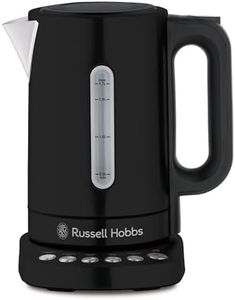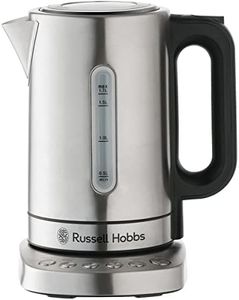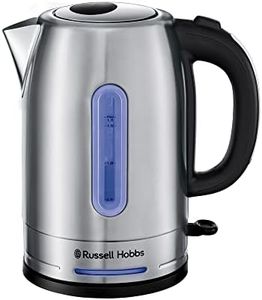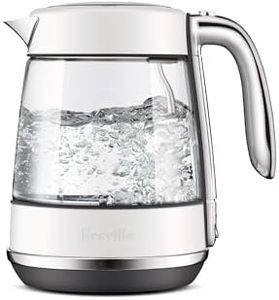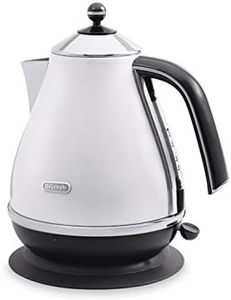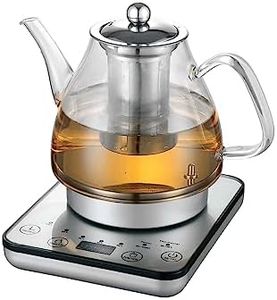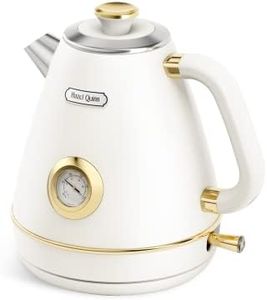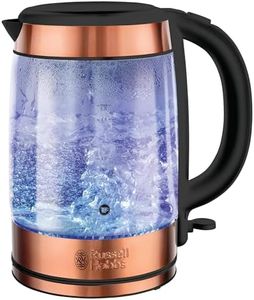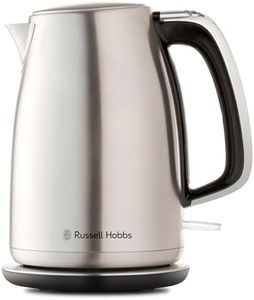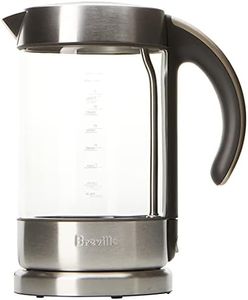We Use CookiesWe use cookies to enhance the security, performance,
functionality and for analytical and promotional activities. By continuing to browse this site you
are agreeing to our privacy policy
10 Best Tea Kettles
From leading brands and best sellers available on the web.Buying Guide for the Best Tea Kettles
Choosing the right tea kettle can make your tea-making process more enjoyable, efficient, and safe. The right kettle depends on your routine, preferences, kitchen setup, and desired convenience. Whether you prioritize speed, temperature control, or traditional aesthetics, understanding the key features can help you navigate the big variety of kettles available, and select the best one for your daily needs.Type (Stovetop vs. Electric)Tea kettles come in two basic types—stovetop and electric. Stovetop kettles are placed directly on gas or electric burners and are appreciated for their classic look and simplicity. Electric kettles plug into a socket and boil water quickly with the press of a switch. The choice is mainly about your kitchen habits: if there's easy access to a power outlet and convenience matters, electric is handy. If you like tradition or want to match your stove, stovetop fits well. Some prefer having both for flexibility.
MaterialTea kettles are commonly made from stainless steel, glass, ceramic, or sometimes copper. Stainless steel is durable, rust-resistant, and easy to clean; glass allows you to see the water level and boiling process but can be fragile; ceramic offers a decorative touch and retains heat well, but is heavier; copper looks beautiful and heats quickly, but requires more care to prevent tarnishing. Your lifestyle and priorities—like durability, aesthetics, or maintenance—should guide your choice of material.
CapacityCapacity refers to how much water the kettle can hold, usually measured in liters or cups. Smaller kettles (about 1 liter or less) are suitable for one or two people or occasional use, while mid-sized (1 to 1.7 liters) work well for small families or frequent tea drinkers. Larger kettles (2 liters or more) suit gatherings or office settings. Consider how many cups you typically make at once, and choose a size that aligns with your everyday needs, to avoid waste or repeated boiling.
Heating SpeedHeating speed matters for convenience, especially if you’re often in a hurry. Electric kettles typically boil water faster than stovetop models. Some display their power in watts: higher wattages heat water faster. For most users, a standard electric kettle is quick enough, but if speed is essential, look for higher-wattage options. Stovetop kettles depend on your stove type—gas usually heats faster than electric coil. Consider your typical wait time and choose accordingly.
Temperature ControlSome kettles, especially electric ones, offer temperature control, letting you choose the exact heat for different teas—green, white, and black teas all have ideal brewing temperatures. Kettles without this feature just boil the water. If you drink a variety of teas or want precision, adjustable temperature settings are useful. If you mostly make black tea or coffee, a basic boil-only kettle will suffice.
Safety FeaturesImportant safety features include automatic shut-off (which turns the kettle off once water boils), boil-dry protection (which prevents heating when empty), and cool-touch handles. Electric kettles typically include more safety features, but stovetop models sometimes have whistles to signal readiness. If you have children or want peace of mind, look for these built-in protections.
Ease of CleaningA kettle that’s easy to clean will last longer and stay hygienic. Wide-opening lids and removable filters or limescale filters (for electric kettles) help make cleaning easier. Materials like stainless steel and glass are easier to keep spotless, while complex shapes or decorative spouts may require more attention. If you live in an area with hard water, ease of cleaning becomes especially important.
Design and ErgonomicsA kettle’s handle, spout, lid, and overall balance all affect how comfortable it is to use. A well-designed handle reduces spills and wrist strain, and a good spout pours smoothly without splashing. Some models have 360-degree bases (electric) or insulated handles. Consider how often you’ll use the kettle, your grip strength, and any mobility needs you have, and look for designs that complement your kitchen and routine.
